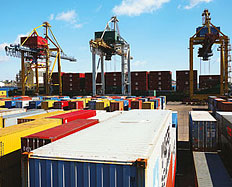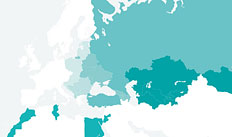COUNTRY ASSESSMENTS
Turkey
HIGHLIGHTS OF THE PAST YEAR
- Economic growth is decelerating. Growth rates have come down from 8.5 per cent in 2011 to 2.9 per cent in the second quarter of 2012, driven by substantially declining domestic demand, a key driver of growth, and spill-overs from the eurozone.
- Structural reforms in 2011-12 were targeted on helping to boost domestic savings through supporting the private pension system. A combination of lower taxes for longer-term bank deposits and state contributions up to US$ 125 per month to the individual’s private pension account were introduced in 2012.
- Efforts to tackle unemployment and improve labour market effficiency are under way. The government has started to implement a number of measures to reform existing labour market regulations, including reduction in severance payments and more flexible working hours.
KEY PRIORITIES FOR 2013
- Municipal financing could attract more private sector investment by decentralisation and further commercialisation. Corporatisation, coupled with good financial performance, is an important prerequisite to attract private sector investors. In addition, expansion of public-private partnership (PPP) structures can complement fiscal decentralisation which would in turn enhance local sustainability, especially in the least developed regions.
- Further capital market development to ensure a stable long-term local currency source. The corporate bond market is still small and asset-backed or covered bond offerings have been limited, but these could provide a viable source for long-term capital – in particular, in light of exposure to a deteriorating eurozone.
- Further reforms in the natural resources sector are needed. Progress should be made in unbundling, corporatising the state-owned gas company and establishing transparent regulatory mechanisms, including setting oil and gas transport tariffs as well as third party storage access.
MACROECONOMIC PERFORMANCE
After a strong growth performance in 2010 and 2011, the Turkish economy has slowed down significantly in 2012. Real GDP grew by only 3.3 per cent year-on-year in the first quarter of 2012, down from 5.2 per cent in the fourth quarter of 2011, and continued to slow in the second quarter, reaching 2.9 per cent year-on-year, its slowest pace since 2009. The key macroeconomic vulnerability of the Turkish economy remains the current account deficit, which stood at 10 per cent in 2011, but has gradually narrowed throughout 2012, with the 12-month rolling deficit reaching 7.9 per cent of GDP in July. To tackle the trade deficit the government raised indirect taxes in several categories of imported consumer durables (mobile phones and some high-end cars) and introduced wide-ranging investment incentives aimed at import substitution in areas such as mining, chemicals and defence electronics that contribute to the trade deficit.
Inflation is only slowly declining from its double digit heights of end-2011. The central bank cut its lending rate for the first time in seven months in September 2012. It also increased banks' reserve option coefficients in order to manage currency pressures associated with potential capital inflows brought about by quantitative easing in the US and the ECB's bond purchase programme. In an effort to help tame domestic consumption, the central bank succeeded in guiding bank credit growth to 19 per cent in August down from as high as 40 per cent in 2010. Moderating food, energy and import prices during the first half of the year has led to a lowering of inflation, which has fallen in recent months to 8.8 per cent year-on-year in August, down from 11.1 per cent in April. The central bank has maintained its inflation target of 5.5 per cent by end-2012, but has revised its end-year inflation forecast in July from 6.5 per cent to 6.2 per cent. Meanwhile, the general government deficit has fallen by more than half to 1.4 per cent of GDP in 2011 from 3.6 per cent in 2010.
The economy is likely to continue to grow but the possibility of a significant drop in growth remains. While the current account deficit has begun to fall, the pace of re-balancing has been moderate in the first half of the year, and there are risks that it will lose momentum in the second half as domestic demand picks up and the lira appreciates. However, the government has also shown its readiness to act promptly if needed to smooth the possible adverse impact of the new global financial turmoil and economic slow-down by the means of monetary and fiscal policies.
MAJOR STRUCTURAL REFORM DEVELOPMENTS
The government is supporting the private pension system with new incentives. The essence of the new law adopted in June 2012 is a combination of tax incentives, such as a zero tax withholding tax rate for equity mutual funds (versus a 10 per cent tax for all other mutual funds), a lower withholding tax rate for longer-term bank deposits and, most crucially, direct government contribution to the private pension system. The government will start matching 25 per cent of individual contributions, up to a limit that is based on 25 per cent of the minimum wage (currently about US$ 125 per month, helping reduce incentives for early retirement). An important difference to other pension systems is that Turkey’s private pension system is a voluntary defined–contribution system with currently only 2.8 million members, and the majority of Turkish citizens still relying on the government-funded social security PAYG (pay as you go) system. The new incentive package is expected to increase pension fund growth, supporting the Turkish government’s overall efforts to help develop local capital markets. However, the reform package does not include any measures towards making overall asset management more competitive.
Progress has been made in developing infrastructure PPPs. The government has identified a number of road sections to be developed on a PPP basis and BOT contracts for both the Eurasia Tunnel and the Gebze-Izmir Road have been tendered, with financing packages currently under negotiation. Also a number of potential PPPs in the railways sector await tendering, including a high speed railway line between Istanbul and Ankara.
Reforms on improving labour market competitiveness are ongoing. As part of a reform package under the “National Employment Strategy (NES)” the government has started to implement changes to mandatory severance pay, flexible working hours as well as providing for different fixed-term contract options. In April 2012 a new incentive scheme was introduced to minimise the cost of labour, whereby new employees hired in the least advanced eastern regions are exempt from employer social contributions and from employee contributions and income taxes.
Some reforms in the financial sector have been adopted to strengthen the robustness of the system and contain expanding credit to the economy. In mid-2011, the Financial Stability Committee (FSC) was established to foster the necessary cooperation between monetary and financial market authorities to contain credit booms fuelled by capital inflows. Members of the committee include the central bank, the Treasury, the Banking Regulation and Supervision Authority (BRSA), the Saving and Insurance Deposit Fund and the Capital Market Board.
The FSC is also tasked with monitoring and containing systemic risk to the financial sector. Additional measures to reign in credit expansion were undertaken in June 2011, in which the BRSA imposed loan-to-value ceilings on commercial, housing and real-estate loans, and raised provisioning requirements on loans. As a result, growth in credit to the private sector fell throughout the year, from 41 per cent year-on-year in June 2011 to 21 per cent in June 2012. Finally, Turkey’s financial sector switched to the Basel II regime in July 2012, encouraging improvements in risk management and mitigation.
An incentive package has been adopted to spur domestic and foreign investments. Having come into effect in June 2012, the new incentives complement the existing incentive structure by encouraging additional capacity in the tradeable sector, with a special emphasis on the least developed provinces. Priority sectors have been identified to receive stronger investment incentives in tourism, mining, rail and maritime transport, and pharmaceuticals. Other incentives target sectors that reduce Turkey’s import dependence.
Agriculture reforms have been accelerated. After identifying around 30 agricultural areas in 2010 designated to receive differentiated support, the government has stepped up its commitments in 2012. Area-based payments are being disbursed, especially for irrigation investments, and land consolidation efforts have been accelerated, particularly in regions that have been defined as top priority, such as the south-eastern and eastern parts of the country. Irrigation projects are being designed to promote efficient use of water.







